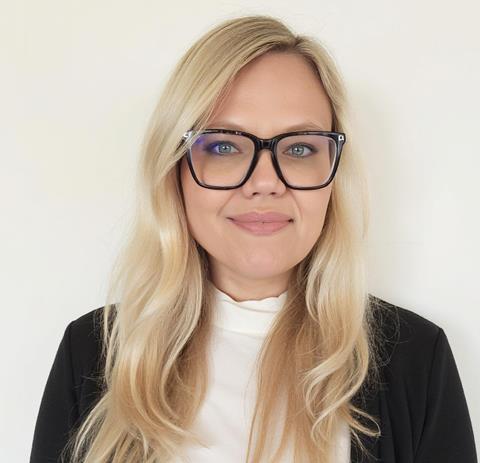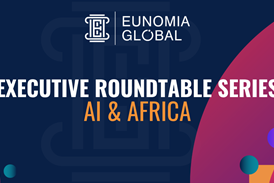Compliance Week Editor-in-Chief Aaron Nicodemus recently interviewed Olga Kozak-Anlar, Compliance AI Lead at Robinhood Markets Incorporated, about her role at Robinhood and the company’s use of AI.
Use of AI tools in compliance, like those described in this Q&A, will be the focus of the Compliance Week event called “The Leading Edge, Applying AI and data analytics in E&C.” The event will be held Jan. 28-29, 2026, at the Westin Fort Lauderdale.
You can listen and subscribe to the Compliance Week podcast on Spotify.
Transcript
Hello everyone, my name is Aaron Nicodemus, Editor-in-Chief of Compliance Week, and also host of the Compliance Week podcast. With me today is my guest, Olga Kozak-Anlar, Compliance AI Lead at Robinhood Markets Incorporated.
Aaron: Olga, welcome.
Olga: Hi Aaron, thank you for having me.
Aaron: Let’s get right into the conversation here.
I have in my notes that you were hired in October of 2024 as the Compliance AI Lead at Robinhood Markets Incorporated, to “lead the newly created AI compliance function at Robinhood within the corporate compliance organization,” which is how it’s described on your LinkedIn profile. Could you tell me a little bit about what the AI compliance function is at Robinhood?
Olga: Absolutely. The compliance AI function at Robinhood is a critical part of AI enablement and this includes the development and implementation of artificial intelligence and internally and externally facing tools, products, and services.

Olga Kozak-Anlar is the Compliance AI Lead at Robinhood Markets Incorporated.
But what does this mean in actual practice? Our function has been instrumental in creating governance and oversight and this includes the creation of AI frameworks, rolling out a formal AI policy, establishing working groups and work streams to ensure collaboration across various functions, and essentially creating transparency in our approach. And all of this is instrumental in upholding the safety always company value, which is at the core of everything that we do at Robinhood.
Aaron: Olga, how does your role fit into Robinhood’s compliance program?
Olga: My role is part of Robinhood Markets within the parent company’s compliance organization and I report to the Director of Corporate and Advisory who oversees several cross-enterprise compliance functions like e-communication review, our control room, along with AI compliance. And ultimately, our AI compliance function reports to the Robinhood Markets Chief Compliance Officer.
Aaron: Most firms don’t have such a specialized function for AI and compliance. Why did Robinhood create it?
Olga: Great question. Interestingly, I first heard about AI compliance roles during an interview at a different job in a different organization.
Their head of risk and compliance mentioned that they just had hired someone for AI and compliance risk. And honestly, I knew right then that that was the role I was interested in and I almost walked out of the room because I knew I was interviewing for the wrong job. And that, I think, was the first time it sort of sparked my interest and knowledge that it does exist.
And then I joined Robinhood maybe six to seven months later. And honestly, I was blown away at how forward thinking the company was about compliance and innovation and AI. And here, compliance truly has a seat at the table and plays a critical role in driving innovation.
Robinhood is unique because it operates at this intersection between tech and finance, making it very fast paced and at the same time very highly regulated, where compliance is always top of mind. But ultimately, I credit our company compliance team for having a vision to anticipate the growing role of AI in the industry. And furthermore, I think this role reflects how Robinhood’s compliance approach has matured alongside shifting priorities from the Securities and Exchange Commission (SEC), the Financial Industry Regulatory Authority (FINRA), the U.S. Department of Justice (DOJ), and of course international regulators.
And we talked about safety always. With the safety always mindset, we’re building a modern compliance model and it has to be agile and data informed and integrated into our tech driven operations. And this includes readiness for emerging challenges like AI risk and cybersecurity and digital asset oversight.
And I want to add that over the past five years, our governance and compliance teams have expanded in size and expertise, underscoring our commitment to integrity, accountability, and trust as we continue to meet an evolving regulatory landscape.
Aaron: Interesting, really interesting. One of the tasks, one of your tasks was to establish governance frameworks. And that’s something you’ve discussed at Compliance Week National Conference in the past. What do these frameworks look like?
Olga: Absolutely. About a year and a half ago, we talked about this at Compliance Week National.
And you probably recall you were in the room. And back then only about, I think, 3% of compliance and risk organizations had any compliance governance in place. And today, fast forward to today, AI is everywhere.
And companies are rapidly adopting AI solutions. And AI governance and compliance frameworks are crucial, because they outline the core parameters and requirements. So we think of it as a foundation or a blueprint of a building, which sets clear governance elements, it defines requirements, and also establishes roles and responsibilities.
So who is responsible for which function? And it’s also a cross-functional document, right? It’s not just compliance. It guides you through your entire governance journey.
And then I can tell you a little bit more, the framework that we developed for Robinhood aligns with regulatory requirements and best practices in AI governance. This includes the National Institute of Standards and Technology (NIST) AI framework, the EU AI Act, and just general best practices across our industry. This may include requirements regarding AI governance and structure. We talked about the sort of roles and responsibilities, but also design and development, right of AI use cases, oversight, monitoring, and just the overall lifecycle of the AI model or use case.
In some organizations, it may mean agreeing to the actual definitions, right, within the AI terminology, like, what do we mean? When we say AI, what do we mean? These may include requirements regarding AI governance and structure (i.e. roles and responsibilities), Design and Development, Oversight and Monitoring, and the overall lifecycle of the AI model or use case. In some organizations, it may mean agreeing on the actual definitions and determining which regulation or requirements you are aligning to.
Aaron: Right, right. So how is Robinhood using AI?
Olga: Robinhood has always been an innovative organization.
AI is an important component, both from how we work, and how we ship product services to our customers. We have multiple enterprise AI tools that our employees use day to day. I am personally using AI tools daily to help me to create draft documents, standardize workflows and summarize regulations, for example.
Our employees overall are very tech savvy, okay. And as a company, that’s in our DNA. We also see innovative solutions in many areas, building agents to help automate processes and workflows, for example, analyzing results helps automate processes, which would normally take hours or days in many instances.
And it’s really becoming an important part of how we work at Robinhood. As an example, 65% of all our support on the CX side is handled by Gen AI. And we’re pairing that with our human-in-the-loop approach, which helps us ensure accuracy, along with required AI safety training for employees.
It’s essential to help us adopt AI responsibly and effectively. On the customer side, Robinhood Cortex is our AI investment tool. And it helps retail traders stay informed by bringing together real time news and market data.
And it helps them answer questions in turn that helps them make more confident investment decisions. I do want to add one important thing. And I know it’s something we discussed at Compliance Week National, as well, we have requirements regarding AI safety training.
And our employees are required to complete training and an attestation prior to using some of our internal Gen AI tools. Furthermore, we also focus on role specific training. And it’s frequently updated to keep up with the ever changing pace of AI innovation.
As you know, that changes quite frequently these days.
Aaron: It does. I mean, I can’t believe it was, just over a year ago that you spoke at National. So much has changed with AI. Thinking back to that conference, I had not even touched AI. And now it is becoming a regular part of the workflow at Compliance Week, you almost can’t remember how you lived without it. And it is still sort of a wild west out there as far as the use cases, but I think a lot of organizations are finding value in it.
Olga: Absolutely. And that’s the case with Robinhood as well.
Aaron: How is Robinhood applying AI tools to compliance use cases?
Olga: As you know, from Compliance Week National, in general, compliance tends to be a little bit unsure. Reluctant.
But I would say that has not been the case with Robinhood. Areas where we have implemented AI solutions include our financial crimes compliance. In fact, we partnered with AWS to help manage financial crimes investigations.
The team developed a fincrimes agent to assist with investigative workflows. And so far, we’ve seen 20% overall productivity improvement for users. At the same time, reducing overall time it takes us to respond to financial crimes events.
So it’s been really significant. And other areas where we use AI and compliance include creating agents to automate workflows, reviews, approvals. But then, compliance policy, for example, we have responses to employee inquiries, monitoring due diligence, regulatory compliance, and more.
And this is really across our businesses and corporate entities. And we are at the moment planning additional use cases. So our teams are actively employing AI solutions to help them automate and augment their work, while ensuring human-in-the-loop is still present.
As you know, we care about accuracy and transparency.
Aaron: What guardrails is Robinhood establishing on AI use? And are they effective?
Olga: That’s a great question. Look, AI is definitely here to stay.
So the focus has shifted to how do we do it responsibly? How do we implement it in a safe and transparent way? And at Robinhood, we’re moving forward with a solid foundation and governance to adopt and deploy AI at scale. And this involves creating sustainable processes and cross-functional governance, which means, you know, everyone needs to work together. To do this effectively, as we mentioned earlier, we started with a centralized AI framework, and it outlined the governance, the roles, the responsibility, and it serves as the foundation which we build upon.
And then we have our key elements or requirements, which are the building blocks. And they are embedded in our overall processes. This means the development and deployment lifecycle.
So, you know, model risk requirements, third-party use case management, QA, and monitoring. So what do you do after you launch these use cases? And of course, the guidance on using our internal tools, you can’t put something out there and not provide guidance and training to employees. It’s important to know that many of the guardrails that we have, we had before, AI are still effective in managing these new risks.
However, as we both know, Aaron, AI can amplify existing risks and even create new ones, right? So it’s important to find a delicate balance, if you will. Continuous monitoring and the ability to react appropriately are key to ensuring that our guardrails are effective.
Aaron: Great, thanks. I am really interested to hear more about how Robinhood is using AI. And I’d love to continue this conversation further.
But for today, I’m going to call it a day and say, thanks to everyone who’s listening. Thanks to everyone who’s reading. And Olga, thanks for joining me.
Olga: Aaron, thank you. And thanks to Compliance Week for having me.
Aaron: Until next time, everyone.


















No comments yet